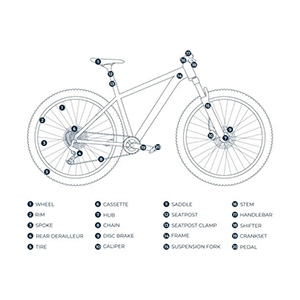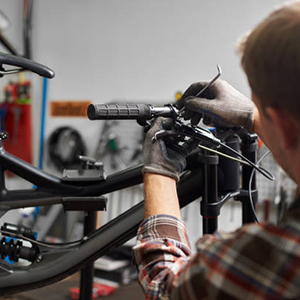
How Long Can A Carbon Fiber Bike Last?
With the widespread use of carbon fiber bicycle frames, they are becoming more and more popular in the market. These bicycles are made of a blend of carbon fiber and resin and are well known for their strength, lightweight design, and durability. However, many riders still wonder: how long can a carbon fiber bike really last?
This is an important question because buying a bike is a long-term investment. Nobody wants to spend a large amount of money only to find out the frame won’t last as expected. Understanding the average lifespan of a carbon fiber bike—and what affects it—can help you make a smarter decision.
In this article, we’ll look closely at how carbon fiber bikes perform over time, what factors influence their lifespan, and how proper care can extend their years of use. By the end, you’ll have a clear picture of whether a carbon fiber bike can truly stand the test of time.
What is a Carbon Fiber Bike?
A carbon fiber bicycle is built with a frame made from tightly woven carbon strands that are bonded together with epoxy resin. This process creates a material that is extremely light, strong, and stiff compared to traditional frame materials like steel or aluminum.
One of the biggest strengths of carbon fiber is how flexible it is to design. Engineers can adjust the shape, thickness, and even the direction of the fibers in different parts of the frame. For example, they can make certain areas stiffer for better power transfer while keeping other areas more flexible to improve comfort. This freedom of design is something metals like aluminum cannot offer.
Carbon bicycles are also known for their ability to absorb vibrations from the road. While an aluminum frame tends to pass road shock directly to the rider, carbon fiber can dampen those vibrations, making the ride smoother and easier on the body during long distances.
Another key advantage is weight. Today, many high-end carbon road bikes weigh under 7 kilograms, which is significantly lighter than most aluminum or steel bikes. At the same time, modern carbon manufacturing techniques allow builders to balance stiffness and flexibility by layering the carbon sheets in specific ways. This is why professional riders and serious enthusiasts often choose carbon fiber for both performance and comfort.

Expert Insights on Carbon Fiber Frame Durability
When it comes to durability, carbon fiber bike frames often raise questions. To get a clear picture, it helps to look at what engineers, bike manufacturers, and professional riders say.
How Long Do Frames Last?
Experts agree that a carbon fiber bicycle frame can last many years—often a decade or more—if it is well cared for and not involved in major crashes. Unlike metal, carbon does not corrode, which gives it an advantage in long-term use.
Strengths vs. Weaknesses
Engineers explain that the strength of a carbon fiber bike frame depends on how the layers are placed. Proper design makes it extremely stiff and resistant to fatigue. However, impacts from accidents or over-tightened bolts can create small cracks that weaken the structure over time.
What Riders Should Know
Professional cyclists point out that durability also depends on how the bike is used. A carbon fiber road bike ridden on smooth pavement can last longer than one regularly ridden on rough trails. With regular inspections and maintenance, most riders will find that a carbon frame remains reliable for many years.
Real Rider Experiences and Long-Term Usage Cases
Many riders are curious about how carbon fiber bikes perform after years of use. Real-life experiences help answer this question.Mountain bikers point out that a carbon fiber frame can handle rugged trails, but impacts from rocks and jumps must be managed carefully. Small crashes may leave minor marks, but a well-designed carbon frame usually remains safe. Riders recommend regular inspection to ensure long-term durability.

Key Factors That Influence Carbon for Bike Lifespan
Titanium
Frame Material
Average Lifespan
Strengths
Weaknesses
Carbon Fiber (Mountain Bike)
10+ years (with care)
Lightweight, strong, smooth ride
Can be damaged by crashes or heavy impacts
Aluminum (Road Bike)
5–8 years
Light, affordable
Small cracks may develop over time
Steel
20+ years
Strong, repairable
Can rust if not maintained
Lifetime
Durable, corrosion-resistant
Expensive
How Long Does a Carbon Fiber Mountain Bike Last?
Modern carbon MTB bikes can last 8–10 years with normal use and care, and some high-quality brands can even exceed 10 years with their carbon frames. Carbon fiber bicycle frames used to be susceptible to UV damage, but this is no longer the case.
The carbon fiber frames manufactured today contain UV stabilizers, which are one of the factors that help ensure the durability of your bicycle.
In addition, you don’t have to worry about using bicycle cleaners on carbon fiber frame bicycles, because carbon is an inert material and is not susceptible to chemical corrosion or salt damage.
Carbon fibers have no real shelf life, and they are very durable and will not rust like the metal on most bicycles.
Always make sure that you buy carbon fiber bikes from trusted and well-known brands to avoid buying low-quality products. The structure of the carbon fiber bicycle frame is very important; it will affect the life of the bicycle.
Do Carbon Fiber Bikes Break Easily?
Due to the strong materials used to make them, carbon fiber bicycles will not break easily. Over time, carbon bicycles have been continuously developed and improved, and technological advances in weaving and epoxy resin are taking place to ensure that the highest quality materials are used to manufacture them.
Maintenance Tips to Extend the Lifespan of a Carbon Bike
Proper care can help your bike stay strong and reliable for many years. Following a few simple maintenance tips makes a big difference.
Cleaning and Storage
Keep your carbon fiber cycle clean by gently washing it with water and mild soap. Avoid harsh chemicals that could damage the resin coating. Store the bike indoors, away from direct sunlight and extreme temperatures, to protect both the carbon frame and components.
Torque Wrench Usage
When tightening bolts on a carbon frame, always use a torque wrench. Over-tightening can create cracks in the carbon layers. Follow the manufacturer’s recommended torque values for seat posts, stems, and other components.
Regular Professional Checkups
Even if your bike looks fine, schedule regular inspections with a professional bike shop. Experts can spot small cracks or signs of fatigue before they become serious. This helps prevent accidents and extends the life of your carbon frame.

Future of Carbon Fiber Technology in Cycling
Carbon fiber bikes have already changed the way people ride, but the technology is still moving forward. Engineers are now experimenting with new resin systems and advanced layering methods to make carbon bike frames even stronger while reducing weight. These improvements will help carbon bikes last longer and perform better on rough terrain.
Conclusion
Not everyone wants a carbon fiber MTB bike, but whether you do will depend on what you are looking for from a bike. It should be noted that carbon fiber bicycles are usually a bit more expensive than other types of bicycles, but you need to pay for the extra strength and durability.
If you are looking for lighter bicycle alternatives, then a full carbon bike may be your best choice. They are also excellent bicycles that provide riders with extra comfort, even better than other types of bicycles.
They can provide you with good support when you are riding a bicycle, and they usually have a shock absorption function that can absorb vibration when you are driving.
Another advantage of all carbon fiber bikes is that they are known to be more efficient and have many additional benefits. Because of all the factors we mentioned in this article, they can perform well, which usually makes them the best choice among all different types of bicycles.
So if you want to be as efficient as possible when riding a bike, then this might be the bike for you.
As we mentioned before, these bicycles can be used for more than 8 to 10 years if they are well taken care of and maintained, so even if the price is slightly higher, it is still a cost-effective purchase. This is because you will not have to change your bicycle for a long time.
You may even find that if you take good care of it, it will last longer than this. Only you can decide whether this is right for you.
If you have your own ideas, please contact us to discuss and provide you with customized services.
Categories
New Blog
Copyright © 2025 Top-Fire Carbon Technology Co., Ltd. All Rights Reserved. Power by

IPv6 network supported